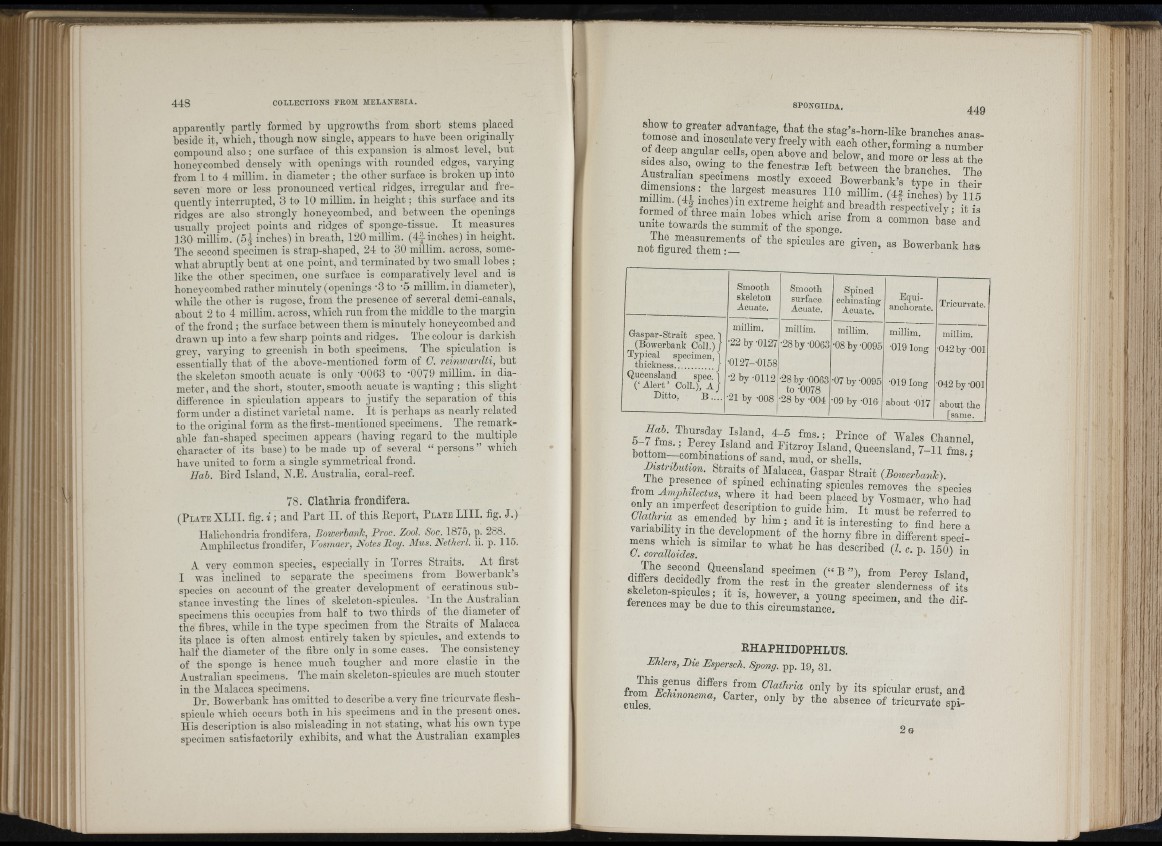
I
apparently partly formed by upgrowths from short stems placed
beside it,”which, though now single, appears to have been originally
compound also; one surface of this expansion is almost level, hut
honeycombed densely with openings with rounded edges, varjung
from 1 to 4 millim. iu diameter ; the other surface is broken up into
seven more or less pronounced vertical ridges, irregular aud frequently
interrupted, 8 to 10 millim. in h e ig h t; this surface and its
ridges are also strongly honeycombed, and between the openings
usually project points and ridges of sponge-tissue. I t measures
130 millim. (5^ inches) in breath, 120 millim. (4|-inches) in height.
The second specimen is strap-shaped, 24 to 30 miilim. across, somewhat
abruptly bent at one point, and terminated hy two small lobes ;
like the other specimen, one surface is comparatively level and is
honeycombed rather minutely (openings -3 to -5 millim. in dimneter),
while the other is rugose, from the presence of several demi-canals,
about 2 to 4 millim. across, which run from the middle to the margin
of the frond; the surface between them is minutely honeycombed and
draAvn up into a few sharp points and ridges. The colour is darkish
grey, varying to greenish in both specimens. The spiculation is
essentially th at of the above-mentioned form of G. reinwardti, but
the skeleton smooth acuate is only '0063 to -0079 millim. in diameter,
and the short, stouter, smooth acuate is wap ting / this slight
difference in spiculation appears to justify the separation of this
form under a distinct varietal name. I t is perhaps as nearly related
to the original form as the first-mentioned specimens. The remarkable
fan-shaped specimen appears (having regard to the multiple
character of its base) to be made up of several “ persons ” whieh
have united to form a single symmetrical frond.
Hah. Bird Island, N.E. Australia, coral-reef.
78. Clathria frondifera.
( P l a t e X L II. fig. i ; and Part I I . of this Report, P l a t e L I II . fig. J .)
Halichondria frondifera, Boiverhank, Proc. Zool. Soc. 1875, p. 288.
Amphilectus frondifer, Vosmaer, Notes Roy. Mus. Netherl. ii. p. 115.
A very common species, especially in Torres Straits. At first
T was inclined to separate the specimens from Bowerbank’s
species on account of the greater development of ceratinous substance
investing the lines of skeleton-spicules. lu the Australian
specimens this occupies from half to two thirds of the diameter of
the fibres, while in the type specimen from the Straits of Malacca
its place is often almost entirely taken by spicules, and extends to
half the diameter of the fibre only in some cases. The consistency
of the sponge is hence much tougher and more elastic in the
Australian specimens. The main skeleton-spicules are much stouter
in the Malacca specimens.
Dr. Bowerbank has omitted to describe a very fine tricurvate flesh-
spicnle which occurs both in his specimens and in the present ones.
His description is also misleading in not stating, what / i s own type
specimen satistactorily exhibits, and what the Australian examples
show to greater advantage, th at the stag’s-horn-like branches anas
tomose and inosculate very freely with each other, forming a number
deep angular ceUs, open above and below, and more or less at the
»-»‘B e n the branch« t t e
Australian specimens mostly exceed Bowerbank’s f-vn« + •
diniensions: the largest measures 110 millim. (4-a i n i s ) bv 115
extreme height and breadth relpectively it is
I f U “ S 7 h :r .r ;:tih “
not f r d X .7 U “ Bewerbank ban
Smooth
skeleton
Acuate.
Smooth
surface
Acuate.
Spined
echinating
Acuate.
Equiancborate.
Tricurvate.
Gaspar-Strait spec.'
(Bowerbank Coll.) '
Typical specimen,'
thickness...............j
Queensland spec. 1
(‘Alert’ Coll.), A j
Ditto, B ....
millim.
•22 by-0127
•0127--0158
•2 b y -0112
•21 by -008
millim.
•28 b y -0063
•28 by -0063
to -0078
•28 by -004
millim.
•08 by -0095
•07 by -0095
•09 by -016
millim.
•019 long
•019 long
about -017
millim.
•042 b y -001
•042 by -001
about the
[same.
5 f t a / U U r i U ‘' ’ A H ’»'"»ea Channel, hnffnr Island and Eitzroy Island, Queensland, 7-11 fms •
hottom--combinations of sand, mud, or shells
S e A “ *»“ “ ' « “»pee B a i t (
from 4 ^ f echinating spicules removes the species
from A n ip h d e c tu s^ F e r e it had been placed by Vosmaer w E a d
a be referred to
• •u-Tt- ly him; and it is interesting to find here a
variability in the development of the horny fibre in different sneei
S U I S “ ^ B r ib e d ( U T iV o) £
^ r i a young specimen, and the differences
may be due to this circumstance.
RHAPHIDOPHLUS.
Ehlers, Die Espersch. Spong. pp. 19, 31
£ S = 2 ; t S - S i Ì S i S
I ' i
' I
i ; ,